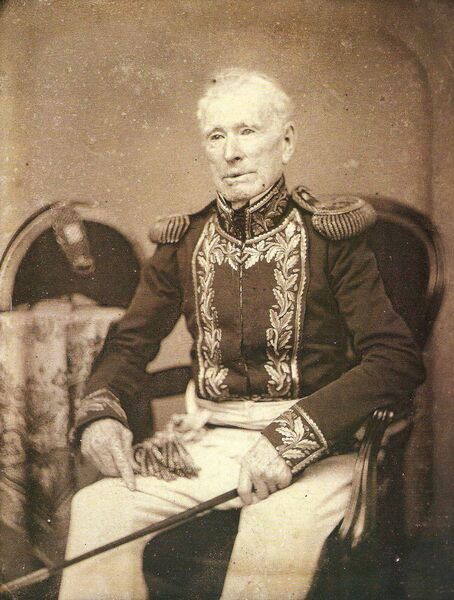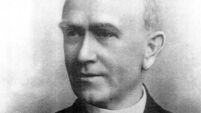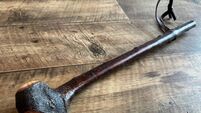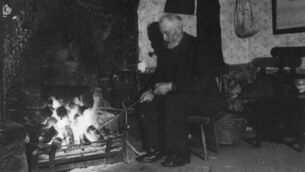Brown's legacy unites Foxford and Argentina

The late JJ O'Hara pays a moving tribute to all who joined and travelled with the Admiral William Brown Society to Argentina in March 2007 to honour Foxford's greatest son. Picture: Henry Wills Archive
While little is known of the early years of William Brown, there is no doubt that his first breath was filled with the heather-scented air that drifted down from the Ox Mountains and that his first games were played along the banks of the River Moy in Foxford.
Like many sons of Ireland who departed our shores, Brown took advantage of the opportunities that came his way and through good timing, good fortune, and good judgement, he soon achieved notoriety and fame. William Brown was to become a distinguished naval officer and one of the most celebrated figures in the history of maritime warfare, particularly on the seas that surrounded South America.
Brown was born in Foxford, on June 22, 1777. At the age of nine he emigrated with his father to America, eventually arriving in Philadelphia. A short time after their arrival, the friend who had invited them to America died of yellow fever. Several days later, William's father also suffered the same fate.
The story goes that one morning shortly afterwards, while he was wandering along the banks of the Delaware River, William met the captain of a ship docked nearby. The captain asked if he wanted employment and young Brown said he did. The captain took him on as a cabin boy, and that simple act set Brown on the path to a distinguished naval career. His time as a sailor took him around the world, providing him with some very valuable experience. He developed skills that marked him out as a naval strategist and eventual commander.
Over the following years, Brown’s early career took him to many places around the oceans of the world. Initially, he joined the Royal Navy, and served in its Atlantic Division for over a decade. He was captured and imprisoned, more than once, but eventually escaped and made his way to England.
After a short while in England he soon took to the waves again, this time employed by the Merchant Navy. While there, he became friends with a man called Walter Chitty. Brown later married Chitty’s sister in Bromley in Middlesex. Depending on which information source one consults, dates get a little muddled at this stage. Nonetheless, Brown’s story forges ahead and shortly after their marriage, Brown and his new wife sailed to Buenos Aires in Argentina.
The Argentine War of Independence was fought between 1810 and 1818, beginning with the May Revolution which ousted the Spanish. The formal declaration of independence occurred in 1816 at the Congress of Tucumán. Despite this, the Argentine navy force was weak and had been repeatedly undone in the early years of the war. Very soon however, and in the aftermath of some early successes, Brown accepted an offer to command the navy. This involved organising and rebuilding the fleet and then re-engaging the Spanish in a final push for independence.

The website, admiralbrownsoc.com, dedicated to Admiral William Brown, is a platform run by the Admiral Brown Society. The site celebrates the rich connections between Ireland and Argentina, “two nations bonded by maritime legacy and shared cultural threads”. In their chronology of Brown’s life, they continue his story.
In the same way that John Barry, from County Wexford, became known as the ‘Father of the American Navy’, William Brown, from County Mayo, become known as ‘The Father of the Argentine Navy’.
The National Museum of Ireland in an information section, Our Irish Heritage, features William Brown in a lengthy contribution provided by Oliver Murphy of the above-mentioned Brown Society. His information is that at one stage, during their War of Independence, Brown returns to Argentine to be honoured.
Murphy concludes his biographical piece with a summary of the various commemorations that have taken place in Brown’s memory in recent years. It is heartening to see that Admiral Brown is seen as a hero in both Argentina and Ireland.
On the centenary of Brown’s death in 1957, the Argentine nation donated a bronze bust of Admiral William Brown to the people of Foxford, and commemorations to mark his death are held in the town annually on the 3rd of March. The Irish Naval Flagship, the L.E. Eithne travelled to Argentina in 2007 at the invitation of the Argentine government, as part of the 150th anniversary commemorations of Admiral Brown’s death. On its return to Ireland, it transported a life size statue of Admiral Brown which was erected on Sir John Rodgerson’s Quay in Dublin.
The website explains the origins of the Admiral Brown Promenade in Foxford and its significance in the ongoing relationship between Foxford and Buenos Aires. The idea of a memorial promenade was first mooted by members of the Brown Society and, in particular, the late JJ O'Hara, who did more than any other person to promote the legacy of Admiral Brown in his native town. The promenade depicts Brown’s life story in 20 bronze plaques and it also includes a statue of Admiral Brown.
The promenade is situated alongside the River Moy in the shape of a ship with stunning views of the river. It was designed by Kevin Keegan, Senior Architect, Mayo County Council. The statue of Brown occupies a prominent place in the centre, was created in Rosario, Argentina and was donated to the Admiral Brown Society by William (Bill) Durkan a native of nearby Bohola.
I have walked along this promenade a few times in recent years and it never fails to remind me of the many ordinary people who left Ireland over the centuries, many who became national heroes in other parts of the world. I like the stance of Admiral Brown, standing proud with his spyglass in hand and his trusty sword slung behind him. The white flag poles standing tall behind his statue and the blue Foxford sky remind me of the flag of Argentina.
These final words, from the Admiral Brown Society, sum up very nicely the legacy of a man who spent his childhood under the shadow of the Ox Mountains.






